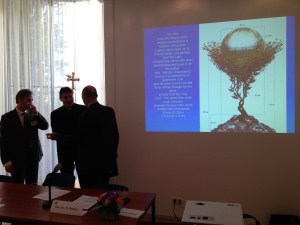Wat maakt een kerk tot kerk?
Tiltenberg-conferentie over

Op 5 en 6 november vond op De Tiltenberg een tweedaagse conferentie over liturgie en gewijde ruimte plaats, in de Engelse taal: "Liturgy and sacred space. Architecture for Divine Worship in the 21st Century". Verschillende bekende sprekers waren aanwezig om het thema toe te lichten - voor een belangrijk deel zijn zij als docent verbonden aan de Master-studie "Architectuur, gewijde kunst en liturgie" van de Europese universiteit in Rome. Een van die docenten is Moeder Anima Christi, die tijdens de conferentie over "the language of beauty" sprak.
Onder de sprekers was ook dr. Laura Bolondi die samen met prof. dr. J. Vijgen de conferentie heeft georganiseerd en destijds haar masterthesis over de Haarlemse kathedrale basiliek heeft geschreven. Ook architect Alberto Cicerone, ontwerper van de nieuwe doopvont voor de Sixtijnse kapel en de Sint Pieter, was erbij evenals prof. dr. Uwe Michael Lang die duidelijk maakte hoezeer het verstaan van het sacrale verbonden is met de theologie. Ook prof. mgr. dr. N. Bux, arch. C. Lomonte en onze eigen Dr. M. Remery hoorden tot de sprekers.
Tijdens de conferentie werd een pontificale heilige Mis gevierd in de kathedrale basiliek van St. Bavo waarbij ik de volgende homilie heb gehouden (ongecorrigeerde tekst). De lezingen waren die van de dag, maandag in de 31e week door het jaar:
Homily
Dear brother priests, brothers and sisters, This beautiful cathedral church was designed with a great awareness of the sacredness that has to characterize such a building.
Every detail was designed with the specific intention of expressing and conveying the meaning of a catholic church in which the sacred mysteries of salvation are celebrated.
In this way, this cathedral basilica is inviting us to reflect upon the meaning of sacred space and to consider carefully the importance of how a church is designed.
When unfortunately a church has to be closed down, as happens many times in our days, we meet with many deep sentiments and religious feelings: this particular church was not just a building, it was the place where they received baptism, first holy communion, this was the church where their holy matrimony took place and where they commended the souls of their beloved ones to Gods mercy.
Even if they rationally know their church cannot be preserved they do everything to prevent it from being closed down and often they feel this closure as a harm done to their relationship with God.
This feeling, which causes a real suffering in our time in our secularized society, highlights however the importance of sacred space; it is not merely a place of gathering: this is the place where people meet their God and Father and His Divine Son, Jesus Christ.
Certainly, great care has to be taken that a church is suitable for the celebration of liturgical services and for the active participation of the faithful (SC 124), but there is more: A church must reflect God’s boundless beauty and as the house of God it must invite all who enter in it, to meet and to adore Him, who is the creator of heaven and earth and who came down from heaven to make us part of His household.
In a church we celebrate that we are part of a building that has Christ Jesus as its cornerstone.
In Him we are being built into a house, where God lives in the Spirit (Ephes. 2, 19-22).
Here we celebrate and receive the abundance of Gods grace.
The second Vatican council has therefore stressed the need of a noble beauty of the sacred space that has to serve worthily and beautifully the dignity of worship; it should invite to faith, piety and express a true religious sense (cf. SC 122-124).
So, we have to enter this sacred building in a spirit of faith and piety, we enter it as children who come in the house of their heavenly Father, therefore, upon entering this sacred space we use the holy water, remembering our baptism.
A truly worthy sacred building, therefore, almost automatically invites us to reflect upon the state and spirit we should possess upon entering the church.
In today’s readings we encounter several aspects of this spirit and I would like to bring to your attention two of them in a special way.
In the gospel reading we hear about a banquet on the sabbath, the day of the Lord.
The Lord teaches the host to invite the poor, the crippled, the lame and the blind because they can not repay him.
Of course, these words of the Lord do touch our hearts as well and the Lord Himself is not acting in a different way: He too invites the poor, the crippled, the lame and the blind at His banquet on His day and we should be aware of this.
Our first and principal awareness upon entering the church should therefore be: that we owe Him everything: our lives, our capacities, our supernatural life, our dear ones, the results of our efforts, everything is entrusted to us by Him and we come to His supper like beggars, poor, crippled, lame and blind, because without Him we cannot bear any fruit; in Him and with Him everything is possible, we will be able to conquer any adversity.
If we remain in Him, we may ask what we will and we will get it (cf. John 15, 7).
Here again, the sacred building contributes a lot: entering a church that expresses the majesty, the beauty and the greatness of God, we almost automatically become aware of our own poorness.
The sacred space prepares us to enter in the spirit in which we commence the sacred liturgy: the spirit of the pure in heart, the spirit of humility of those who hunger and thirst for Gods grace.
A second aspect of the attitude that we should possess upon entering the church, is the love for each other: "Be of the same mind, with the same love, united in heart, thinking one thing.
Do nothing out of selfishness or out of vainglory; rather humbly regard others as more important than yourselves", Saint Paul told us in today’s first reading.
This same spirit of humility that characterizes our relationship with the Heavenly Father, should be a fundamental characteristic as well of our human relationships.
Here as well the sacred space helps us to live this spirit: entering a church we enter a wider space, that transcends us, poor human beings; in the church we are at home, but it is not our house: it makes us feel humble, we are invited to have a broader view, to look at our own concerns in a wide perspective and so we become to realize that we are part of the communion of saints, and that we, our needs and our desires are not in the centre of everything, but that we are part of that big, great family of God and that we are invited to look at each other as brothers and sisters in Christ and foster unity.
If we reflect upon the greatness of God and His boundless love for each of us, how could we continue to be so concerned for our own little worries.
Dear brothers and sisters, I truly hope and pray that these days will contribute to a new awareness of the spiritual importance of sacred space, that this conference and every sacred space may help us to live that spirit that animated Our Lord Himself who emptied Himself for our salvation and gather us in unity with Him so that all beings bend their knees in the name of Jesus to the glory of God the Father (cf. Phil. 2, 6-11).
AMEN.
















